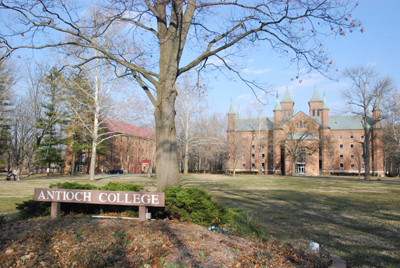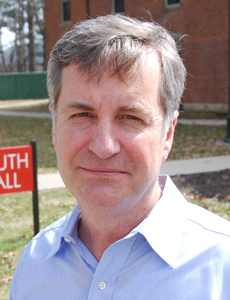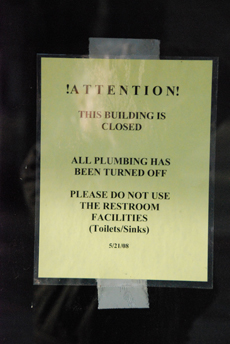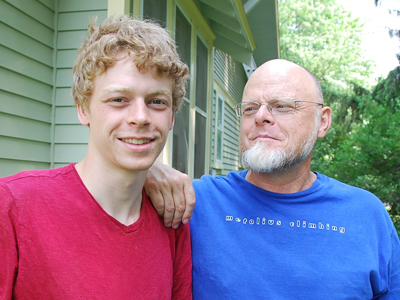Antioch College alumni were back on campus this summer volunteering to tile bathrooms, scrape peeling paint, yank weeds and refinish furniture. For decades, they've been pulling on work gloves in the week before the annual college reunion to help maintain a small liberal arts school that always seems to struggle financially.
In summer 2011 the cause was especially urgent.
Joan Stockton of Philadelphia - class of 1965 - was helping reclaim a sculpture annex that had been covered in graffiti. The building stood vacant for several years. "This place is important," Stockton said. "We alumni refuse to let this place die."
Antioch College is trying to revive itself after shutting down in 2008. A determined group of alumni is struggling to restart the once highly esteemed school in Yellow Springs, Ohio. Antioch closed shop after years of financial problems and plummeting enrollment. College officials say the new Antioch will create a sustainable, affordable, 21st century model for small, liberal arts colleges.
This is hardly an auspicious time to start - or restart - a college such as Antioch. With a beleaguered national economy, fierce competition for students and a dwindling share of the higher education market, all but the most elite and well-endowed small colleges are peering warily into an uncertain future.
"I think the tough question for us is, how do you not look like everybody else?" says Antioch's new president, Mark Roosevelt. He was previously the superintendent of the Pittsburgh public school system.
Antioch won't have any trouble distinguishing itself, at least for the first few years. It has admitted a class of just 35 for this fall. They'll arrive on a campus with six tenure-track tenured faculty members and another half dozen visiting or adjunct professors. Eight of the college's 25 buildings will be open, including one dorm and one classroom building.
All four years of tuition is free for this first batch of students. Most of them are also getting financial aid for their room and board. Plenty of risk comes with the deal at no extra charge.
The college's trustees have pledged $9 million over the next three years to help cover operating costs, but more money is needed to meet the projected three-year, $27 million budget. Another risk is whether Antioch will win back its accreditation, which it lost when it closed. Accreditation certifies that a college or university meets basic standards of quality. Antioch will have to produce its first class of graduates before becoming fully accredited. If the school folds before this year's class graduates, other institutions may not accept the course credits that Antioch students will have earned.
"I think they're taking a gamble," Roosevelt says of the incoming class. "I don't think the biggest part of the gamble is accreditation because I feel very confident that we will win accreditation. But this is an unusual experience we're asking these students to dedicate themselves to. It's not going to be right for all kids."
A Tangled History
The story of Antioch's decline is the subject of fierce debate among those involved. To put it simply, some say the college's mission and independence got lost in a national expansion of adult education extension campuses under the name Antioch University. Some say the alumni failed to give enough money to the school. Some say the historically left-leaning campus devolved into militant and sometimes vicious intolerance, what the conservative magazine The Weekly Standard called "death by political correctness."
There's no dispute that Antioch's closing marked a sad end to a scrappy, 155-year-old institution with an impressive alumni roster and a storied history.
Antioch College was founded as a nonsectarian school in 1853 by Christian and Unitarian church organizations. They chose a scenic patch of high ground near Ohio's Little Miami River, northeast of Dayton. Antioch's first president was the seminal education reformer Horace Mann, regarded as the father of the American public school system. From its earliest days, Antioch offered an equal education to women and men, whites and African Americans.
In the 20th century, Antioch became known as a competitive and progressive institution that claimed to produce more students who went on to get Ph.D.s than any other college in the country. Its graduates included civil rights leader Coretta Scott King, anthropologist Clifford Geertz, paleontologist Stephen Jay Gould, and Nobel laureates José Ramos-Horta and Mario R. Capecchi. Antioch College's enrollment reached a peak in 1972 of 2,407 students.
When Antioch closed in 2008, fewer than 300 students remained. An alumni-controlled group later reached a $6 million deal to separate the original Antioch College and its long-neglected campus from the adult education division called Antioch University, which continues to operate five adult education campuses in Ohio and three other states.
Now comes the task of reinvention.
Back to the Future
In one way, Antioch College is back where it started - tiny. The first graduating class numbered 13, including three women. It offered a conventional curriculum for its time: Latin and Greek, English, history, philosophy, mathematics and science. This year's class can pursue individually crafted majors in the core disciplines of the modern liberal arts college: literature, history, science, philosophy, social sciences, mathematics and the arts.
"We had very limited funds; we had to start very small and build up slowly," says former Antioch literature professor Jean Gregorek. She was on a team of former faculty who designed the new curriculum. "In fact, there's a lot you can do with history, literature or philosophy or anthropology," she says. "We're used to doing a lot with a little."
Another cornerstone of the new Antioch is a renowned feature of the old Antioch: the off-campus work program. Since 1920, Antioch has required students to alternate each term on campus with a term of full time, paid work off campus. Students work across the country and internationally at businesses, schools, social-service programs and government agencies. The program is meant to connect the abstract world of the academy with the real world of work and professions.
"It's a good idea that, if you want to be a doctor, you actually work in a hospital before that," says retired Antioch history professor Bob Fogarty. "You get to see the sight of blood. You may not like that. You may fall over the first time you see it. So the program allowed students to begin to make decisions with regard to what they may like to do."
Lee Morgan (class of 1966) is a retired Minnesota businessman and chair of the Antioch board of trustees. His work terms included selling carpets and managing Santa Claus at a department store, working in a printing factory and as a travelling salesman to bookstores, and clerking at the U.S. Department of Commerce. "You can always tell an Antiochian because they can recite every job, in order, that they had," Morgan says.
Students don't get academic credit for the work program. Because the school plans to operate year-round, those who want to take summers off will have to spend five years getting a bachelor's degree instead of four.
A new feature tying together Antioch's academic and work programs will be global seminars. These will explore present-day sustainability problems like food, energy and water. The seminars will be co-taught by faculty from different disciplines and are meant to connect the liberal arts with pressing issues by helping students understand the broad context of a problem.
"Water could be taught by a poet, by an ecologist, by somebody from the philosophy department, because it has such enormous reach in our lives," President Mark Roosevelt says. "So that's a liberal arts education in preparation for work and for life."
Lean and Affordable
While the first class of students gets the promise of a free, four-year college education, Antioch will eventually have to start charging money. The advertised tuition, fees, and room-and-board for the 2012-13 year are $35,702. The price tag is about average for a private, residential four-year college, according to the College Board. But Lee Morgan hopes Antioch can drive that cost down, perhaps by $10,000 or more.
"The way to do that, frankly, is to have a core group of programs in the early years so that people take pretty much the same courses. They have a common basis of dialogue, and critical inquiry and civil discourse. But the notion is we don't offer a hugely wide variety. And that way we think we can reduce the cost," Morgan says.
From Morgan's perspective, Antioch has an economic advantage in remaking itself from scratch. Closing down meant tenured faculty could be laid off, low-performing departments shuttered. Morgan notes that for-profit colleges and universities have learned how to control costs. "It's time for the nonprofits to step up and cast off their endowed chairs and all the other constraints that are inhibiting their ability to innovate and to start rethinking how they're structured," he says.
Only one of the six tenure-track faculty members hired for the reopened Antioch taught at the school when it closed. This has caused deep bitterness among some alumni and former professors. Literature professor Jean Gregorek chose not to apply for one of the new slots to protest what she sees as unjust treatment of the former faculty.
"We all lost our jobs and then many of us stayed and fought that closing," Gregorek says. "The college was repurchased partly because of our efforts. And then they were like, OK, thanks."
The Gamblers
Young people from Maine to Mexico were accepted for admission this autumn. Forrest Humphrey of Viroqua, Wis. graduated from a tiny, rural high school started by students and based on the alternative Waldorf School model. When Humphrey toured conventional Midwestern colleges they felt cut off from real life. He says Antioch's work program promises the opposite. "I wasn't really too interested in just being enclosed in a campus for four years," Humphrey says. "I want to be out in the world and explore."
Humphrey's dad, Bill, is an outdoor educator and a shamanic healer. His mom, Ellen, is a licensed acupuncturist. Their town of Viroqua has a counter-culture feel similar to Yellow Springs. Because Forrest graduated in a class of just 10 people, Bill was initially worried about the small group his son would be joining at Antioch. But a visit to campus and a bit of reflection eased Bill's mind. "We each have our own paths to walk, and wherever we are we are learning," Bill says.
Ellen likes the idea that Forrest will be mixing academics with on-the-job experience. "I learn by doing. So I'm really excited that he'll have the opportunity to try a number of different careers for a short period of time and see what might fit," she says.
Eva Erickson will also be at Antioch this fall. She's been there before. Erickson was a freshman during the old Antioch's last year of operation. She wants to be a public school history teacher, and was drawn to Antioch's traditions of multicultural studies and social activism. "I didn't want to go to a place that was affluent, elite," Erickson says. "It's a college that sets its framework around fighting for social justice. That really spoke to me."
Erickson decided to stay in Yellow Springs and do what she could to fight for Antioch's survival. She worked at a variety of local jobs to support herself and took classes with a group of laid-off professors who, with alumni backing, started a Nonstop Liberal Arts Institute during the time Antioch was closed.
Erickson says she was hurt and disappointed that more former faculty members were not rehired. But she's ready to get back to school. Still, as a 22 year old freshman, Erickson worries that Antioch might not last the four years it will take to earn her degree. "I'd probably have to start all over again," she says. "That would really suck."










